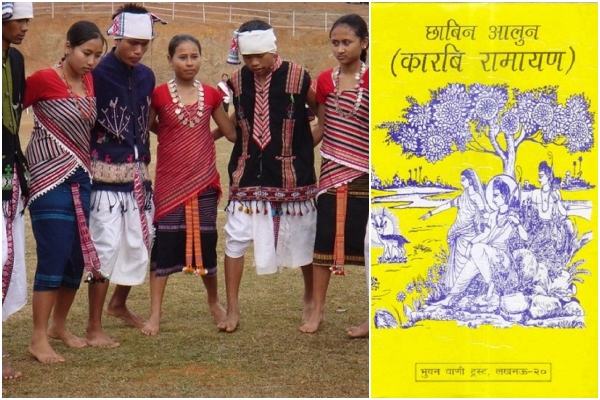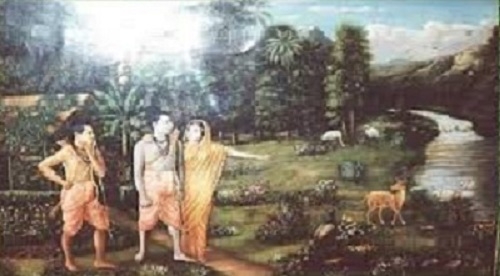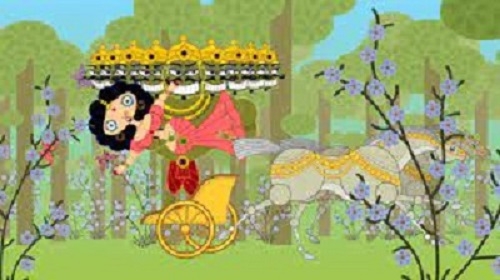Sabin Alum the Rama Story in vogue among the Karbi janjati of Assam
Total Views |
The Karbi, people who were earlier known as Mikir, represent one of the major hill janjati of Assam the other being the Dimasa Cacharis of the North Cachar Hills. They, however, call them as “Arleng” meaning ‘Man’ or human being. The Karbi Anglong District with headquarters at Diphu, is the main habitat of these Karbi janjati people. However, their habitats are also found in North Cachar Hills, Sibsagar, Nowgong and Darang districts of Assam.
The folklores of Karbi Janjati indicate that they lived on the banks of Kolong and Kapili Rivers and the entire area of Kaziranga, the famous jungle safari spot of today. The Karbi people had their own kingdom adjacent to the Jaintia Kingdom in Meghalaya. They are among the people who occupy a prominent place in the social and cultural life of Assam. Most scholars believe them to be of the Tibeto-Mongoloid stock that had migrated to Assam from South East Asia. However, scholars like late Padmashri Dr. V S Wakankar, who discovered the 40,000-year-old cave paintings of Bhimbetka, prefer to call them Indo-Tibetans.

Many prominent western scholars, anthropologists and sociologists including Edward Stock, Grierson etc. did study these janjati people from various angles and inferred that they had migrated to their present habitat from South East Asia along with other janjatis like the Bodos, Nagas and Kukichins. Swami Bangovind Parampanthi of Assam recounted a different tale. He says that the story of their origin as told by older people of their community has some interesting aspects. They say those people who fought against the Rakshasa King Ravana in defence of Sri Ram are called Karbi as they carried the arrows (KAR-Arrow) of Sri Ram. By extending support to Sri Ram they believed that they stood for Truth which ultimately triumphed over falsehood.
The Karbi people trace their origin to Tretayuga when the Ram-Ravan battle took place. The Swami quotes one Charan Terrang, a Karbi village headman who lived 115 years to substantiate his point. Terang told him that during the Tretayuga their people sided with Sri Ram and they used to carry the arrows (Kar) of Sri Ram. Hence, they are called Karikiri. From this word the present Karbi came into vogue as its corrupt form. It is interesting to know that the Karbis have their own Ramayana which is known as “Sabin Alun” or the Song of Ramayana and this is sung within three days. Their story of Sri Ram has certain variations but the main framework of Ramayana remains the same. According to Swami Bangovind Parampanthi, Karbi is the only community who possesses such Ramayana Song in its entirety in the region.
According to Karbi tradition, there was no such song earlier. So Hemphu (the Supreme God) asked Rangsena, the musician, to compose a song. “So, you go down to the earth to start music among the Karbis”, said Hemphu to Rangsena. This Rangsena took birth as Mirijang brothers and composed the Sabin Alun, according to Karbi belief. Madhav Kandali, the famous Assamese poet first rendered Valmiki Ramayana into Assamese language in the 14th century under the patronage of Cachari or Barahi King Mahamanikya. The Karbi Ramayana known as ‘Sabin Alun’ i.e. ‘Song of Sabin’. According to traditional belief this Sabin was from village Kandali, a place situated in preset Nagaon district of Assam bordering Karbi Anglong. It is also adjacent to a place called Doboka that was the capital of King Mahamanikya. This Sabin, who composed the ‘Sabin Alun’ is believed to be contemporary of Madhav Kandali according to some scholars.

The original story of Sri Rama as told by Sage Valmiki has changed at the hands of Karbi poets to such an extent that at places it appears an entirely different version with additions and variations concurrent with the traditions and customs of the Karbi community. For example, King Janaka of Mithila is a farmer who sits on the top of a ‘tongi’, a makeshift hut built on the top of a tree ( Machan?) to monitor cultivation in the field. As per the instruction of God Vishnu, his consort Lakshmi takes birth in the house of King Janaka. She appears in the form of a peahen’s egg and remains visible in the field. Some cowboys found this unusual looking egg and brought it to the king. The king rules that since the peahen’s egg is not edible, it should be kept in the custody of the queen Hemphi. Some days later, queen Hemphi finds a beautiful girl in place of the peahen’s egg which she adopts as her daughter and names her ‘Sita’.
As per the Karbi Ramayana, Vishnu assures the gods of deliverance from the atrocities of Rakshasa King Ravana and his brother (not son) Meghanad. Ravana is supposed to have 12 heads instead of 10 as per other versions of Ramayana. Once King Janaka was gone for some work and in his absence the royal compound was covered with thick vegetation that was cleared in a single day by Sita and in doing so she discovered a bow made of iron. The bow was lying hidden under the thicket for generations. Sita lifted the bow in one hand and relocated it to its original place with her other hand. When King Janaka returned he was surprised to find the courtyard cleaned and the bow kept in its original place. He was happy to know that all this was done by young Sita. That very day he decided in consultation with his queen that whoever would lift the bow would marry Sita.
King Dasarath had two wives – one from the human race and the other from the demon race. To have children the King prays to Yama who advises him to go to a jungle where there is an orange tree full of fruits. The King should fire only one missile and take whatever fruit that falls from the same. Dasharath did as per Yama’s advice and got one orange. His younger queen Hiyipee who came from the demon race consumed the whole fruit throwing the rind. The elder queen Chakarbi got hurt at this behavior but she did eat the rind. With the passage of time both the queens became pregnant and gave birth to one son each. They were named as Ram and Lakshman. At the time of their birth, the crown of Ravana fell which he considered as an indication of some strongman’s birth on the earth. He dispatched his ministers to ascertain his suspicion. They went in all directions, found Ram and Lakshman but could do no harm to them.
Here King Janaka decided to hold the marriage of Sita and notified all the kings. Ravana was also invited to this marriage. When he arrived, King Janaka honored him and welcomed to the event. He tried to lift the bow but could not do so even after applying all his might. Janaka also invited Ram and Lakshman for the marriage ceremony. Ram with the permission of his parents proceeded to participate in the ceremony accompanied by Janaka’s messengers. On the way they told the two princes that the short way to Janaka’s kingdom passes through thick forest which was under control of a terrible looking demoness. Unfazed, Ram and Lakshman opt for the short route and eliminate the demoness on the way. (This seems to be an obvious reference to the killing of demoness Tadaka at the advice of sage Vishwamitra).

When the princes of Ayodhya reached Janaka’s place they were received with due honor and respect. As Ram approached the bow and with sincere prayer to God, lifted it easily, he warned the gathering to shut their eyes and ears and hold firmly to the ground. However some people did not heed to his words and had to suffer for their negligence. According to Karbi belief, the lame, deaf and dumb are those people who did not pay attention to Rama’s advice. Ram broke the bow and King Janaka offered his daughter Sita in marriage to him. After her marriage, Sita stays back at King Janaka's house and Ram also stays with his young wife as a 'gharjamai'. Lakshman gives company to Ram and both the brothers assist Janaka in his jhum cultivation, the Karbi Ramayana says.
The Parshuram story is also incorporated here. Only his name is Bongpan Kathar (the man with an axe) and it is Laxman who challenges him and not Ram. Lakshman dares him to move his palm which Parshuram could not and loses all his power. However, Bongpan Kathar robbed Ram with his power which was later restored by Rama’s maternal uncle ‘Mumurambhet’ or Womu (Jatayu) just before his death. Ram allowed the mortal remains of Jatayu to be burnt on his chest as no holy place was available. The fire continued to burn for three days. At last Lakshman had to fetch water from the Deopani River to douse the fire.
After staying at Ayodhya for few days, King Dashrath suddenly exiled Ram, Lakshman and Sita to Narayan Hills for 12 years. According to Karbi Ramayana Rama was sent to exile in the Narajon (Narayan) Hills where the bird Womu (Jatayu) was also cremated. Rama of Sabin Alun tried to end his life by jumping in the funeral pyre. At this juncture, Lakshman brought water from the Deopani River in polo, a fishing implement, and doused the fire. Later on both the brothers took bath in Deopani River and set out to rescue Sita. (To be continued)
.
.
